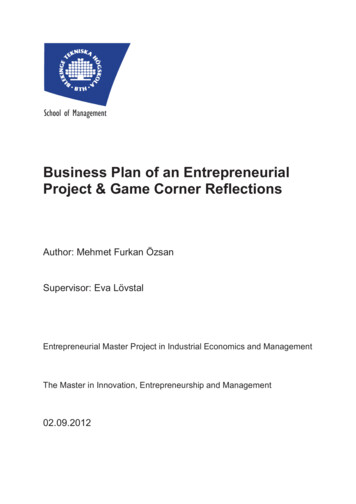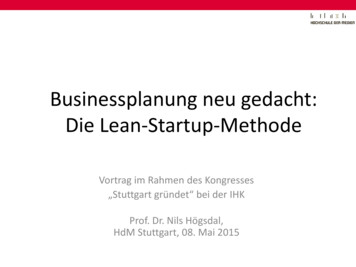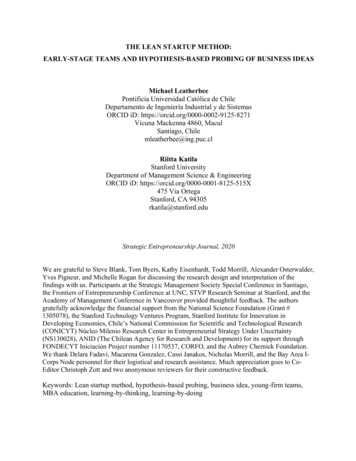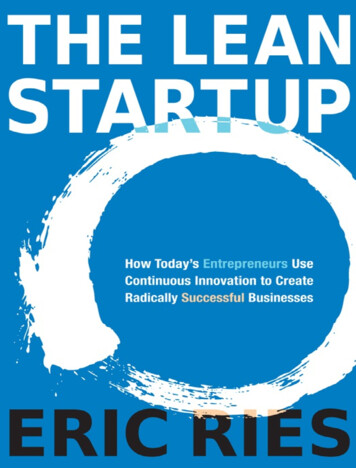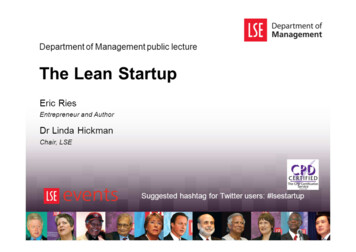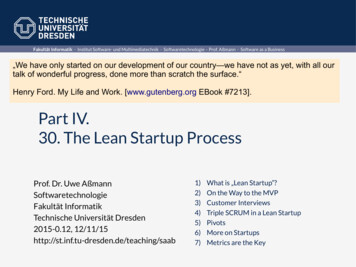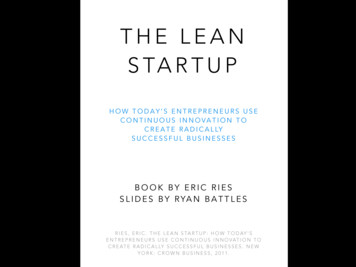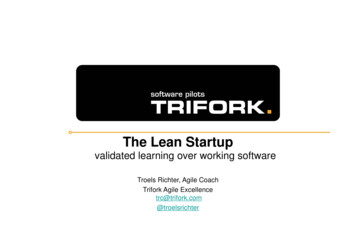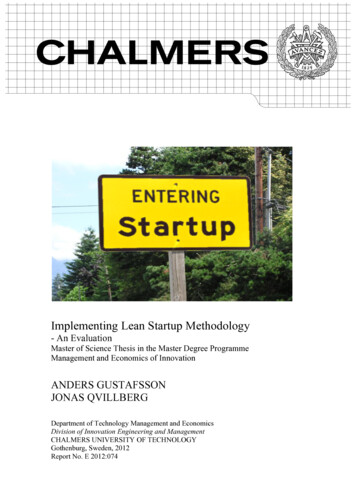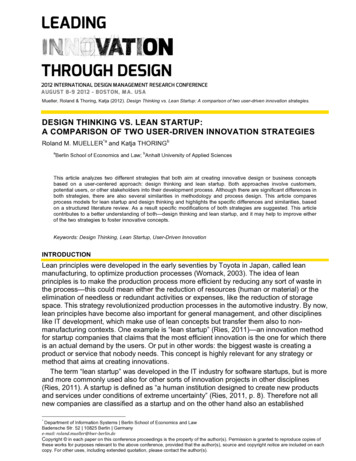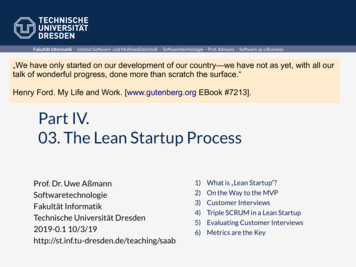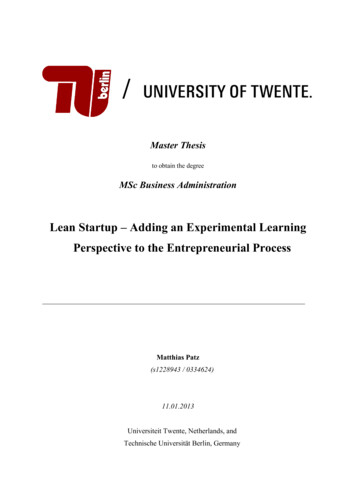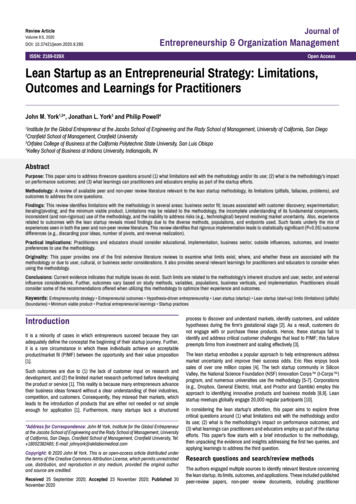
Transcription
Journal ofReview ArticleVolume 9:5, 2020DOI: 10.37421/jeom.2020.9.285Entrepreneurship & Organization ManagementISSN: 2169-026XOpen AccessLean Startup as an Entrepreneurial Strategy: Limitations,Outcomes and Learnings for PractitionersJohn M. York1,2*, Jonathan L. York3 and Philip Powell4Institute for the Global Entrepreneur at the Jacobs School of Engineering and the Rady School of Management, University of California, San DiegoCranfield School of Management, Cranfield University3Orfalea College of Business at the California Polytechnic State University, San Luis Obispo4Kelley School of Business at Indiana University, Indianapolis, IN12AbstractPurpose: This paper aims to address threecore questions around (1) what limitations exit with the methodology and/or its use; (2) what is the methodology's impacton performance outcomes; and (3) what learnings can practitioners and educators employ as part of the startup efforts.Methodology: A review of available peer and non-peer review literature relevant to the lean startup methodology, its limitations (pitfalls, fallacies, problems), andoutcomes to address the core questions.Findings: This review identifies limitations with the methodology in several areas: business sector fit; issues associated with customer discovery; experimentation;iterating/pivoting; and the minimum viable product. Limitations may be related to the methodology, the incomplete understanding of its fundamental components,inconsistent (and non-rigorous) use of the methodology, and the inability to address risks (e.g., technological) beyond resolving market uncertainty. Also, experiencerelated to outcomes with the lean startup reveals mixed findings due to the diverse methods, populations, and endpoints used. Such facets underly the mix ofexperiences seen in both the peer and non-peer review literature. This review identifies that rigorous implementation leads to statistically significant (P 0.05) outcomedifferences (e.g., discarding poor ideas, number of pivots, and revenue realization).Practical Implications: Practitioners and educators should consider educational, implementation, business sector, outside influences, outcomes, and investorpreferences to use the methodology.Originality: This paper provides one of the first extensive literature reviews to examine what limits exist, where, and whether these are associated with themethodology or due to user, cultural, or business sector considerations. It also provides several relevant learnings for practitioners and educators to consider whenusing the methodology.Conclusions: Current evidence indicates that multiple issues do exist. Such limits are related to the methodology's inherent structure and user, sector, and externalinfluence considerations. Further, outcomes vary based on study methods, variables, populations, business verticals, and implementation. Practitioners shouldconsider some of the recommendations offered when utilizing this methodology to optimize their experience and outcomes.Keywords: Entrepreneurship strategy Entrepreneurial outcomes Hypothesis-driven entrepreneurship Lean startup (startup) Lean startup (start-up) limits (limitations) (pitfalls)(boundaries) Minimum viable product Practical entrepreneurial learnings Startup practicesIntroductionIt is a minority of cases in which entrepreneurs succeed because they canadequately define the conceptat the beginning of their startup journey. Further,it is a rare circumstance in which these individuals achieve an acceptableproduct/market fit (P/MF) between the opportunity and their value proposition[1].Such outcomes are due to (1) the lack of customer input on research anddevelopment, and (2) the limited market research performed before developingthe product or service [1]. This reality is because many entrepreneurs advancetheir business ideas forward without a clear understanding of their industries,competition, and customers. Consequently, they misread their markets, whichleads to the introduction of products that are either not needed or not simpleenough for application [1]. Furthermore, many startups lack a structured*Address for Correspondence: John M York, Institute for the Global Entrepreneurat the Jacobs School of Engineering and the Rady School of Management, Universityof California, San Diego, Cranfield School of Management, Cranfield University, Tel: 18052382485; E-mail: johnyork@akitabiomedical.comCopyright: 2020 John M York. This is an open-access article distributed underthe terms of the Creative Commons Attribution License, which permits unrestricteduse, distribution, and reproduction in any medium, provided the original authorand source are credited.Received 25 September 2020; Accepted 23 November 2020; Published 30November 2020process to discover and understand markets, identify customers, and validatehypotheses during the firm's gestational stage [2]. As a result, customers donot engage with or purchase these products. Hence, these startups fail toidentify and address critical customer challenges that lead to P/MF; this failurepreempts firms from investment and scaling effectively [3].The lean startup embodies a popular approach to help entrepreneurs addressmarket uncertainty and improve their success odds. Eric Ries enjoys booksales of over one million copies [4]. The tech startup community in SiliconValley, the National Science Foundation (NSF) Innovation Corps (I-Corps )program, and numerous universities use the methodology [5-7]. Corporations(e.g., Dropbox, General Electric, Intuit, and Proctor and Gamble) employ thisapproach to identifying innovative products and business models [8,9]. Leanstartup meetups globally engage 20,000 regular participants [10].In considering the lean startup's attention, this paper aims to explore threecritical questions around (1) what limitations exit with the methodology and/orits use; (2) what is the methodology's impact on performance outcomes; and(3) what learnings can practitioners and educators employ as part of the startupefforts. This paper's flow starts with a brief introduction to the methodology,then unpacking the evidence and insights addressing the first two queries, andapplying learnings to address the third question.Research questions and search/review methodsThe authors engaged multiple sources to identify relevant literature concerningthe lean startup, its limits, outcomes, and applications. These included publishedpeer-review papers, non-peer review documents, including practitioner
York JM, et al.publications (e.g., Harvard Business Review, Sloan Management Review,Rotman Management Magazine), graduate theses, business publications,blogs, and books, and non-peer-reviewed web content. Electronic databasesreviewed included ABI/Inform, EBSCO, JSTOR, Google [and Google Scholar],ProQuest Dissertations and Theses, Science Direct, and Web of Science.The search strategy started with the use of keywords relating to the leanstartup. These included "lean (or agile)", "lean (or agile) entrepreneur", "lean(or agile) entrepreneurship", "lean (or agile) start*up (startup, startup)", "lean(or agile) venture". For the first question, the strategy added modifiers to "leanstart*up*", including "barrier*", "challenge*", "disadvantage", "drawback*","issue*," hurdle*", "limit*," limitation*", "pitfall", or "problem*". For the secondquestion, the strategy added the following terms, such as "failure", "impact","new venture performance", "outcomes", "performance", and "success" to thesearch string. There were no specific search strings used for the third questionsince the investigation would inform our response and recommendations toaddress it.A broad search captured 300 citations, as late as the end of 2019, that includedthe lean startup in the title or abstract. The search concerning the first andsecond questions led to 250 citations that included the lean startup in the titleor abstract to examine further. From the search results, the authors’ choice ofcitations depended on their knowledge related to entrepreneurship, startups,and the lean startup practices to extract value from a source's content. Theseincluded published peer-review papers and non-peer review documents(e.g., graduate theses, business publications, blogs, and non-peer-reviewedweb content). A closer examination led to identifying a limited number ofpublications that specifically looked at the lean startup and its limitations toaddress the first question and the lean startup and outcomes to address thesecond query.Due to the limited peer-review papers drawn from this initial effort, the researchincluded citations from non-peer review pieces. Most of the publicationsinvolved those from advocates and practitioners describing the methodology.These works were predominantly in the non-peer review space and includedtrade publications and blogs describing the methodology. Furthermore,the review employed a "snowball" approach involving identifying additionalcitations from relevant references from articles reviewed from the initial searchand did not appear. The authors examined such articles for relevance basedon the specific research questions and knowledge related to entrepreneurship,startups, and lean startup practices to extract value from a source's content.The authors reviewed these pieces and included those that provided relevantdata to address the research questions.Lean startupThe lean startup, a term Eric Ries coined, describes a scientific (or hypothesisdriven) methodology for developing businesses and products. The approachaims to shorten the product development cycle by adopting a combinationof hypothesis-driven experimentation, iterative product releases, validatedlearning, and customer feedback [11,12].The lean startup draws on the Toyota Production System and agile softwaredevelopment [13,14]. Furthermore, its foundation includes several academictheories bricolage, business model, creation and discovery, dynamic capabilities,effectuation, organizational learning, and real options [15-27]. Finally, thismethodology stands on scientific literature support, ranging from moderate (forexperimentation and minimum viable product [MVP]), to robust (for effectuationand iteration), to very strong (for customer involvement) [12].Several components define the methodology. The first involves customerdiscovery, where the startup focuses on identifying the customer, his/herneeds, repeatable business model, and product/market fit P/MF. Discoveryinvolves direct customer conversations, with the entrepreneur "getting outof the building" ("GOOB") to understand criticalissues and confirm thecustomer's problem or "job-to-do" [8,28-30]. The entrepreneur's job is toget inside the customer's head to discover and validate the problem anddetermine whether one's proposed solution might work. Such insights canspeed the construction and validation of an MVP and a scalable businessmodel.Page 2 of 10J Entrepren Organiz Manag, Volume 9:5, 2020The next piece involves experimentation [11,19,29]. Ries [29] fashions thelean startup as a scientific approach using hypothesis testing to providevalidated learning to guide decisions. This phase involves the running ofexperiments and the "build-measure-learn" (BML) cycle [11,29].Essential to this process is the minimum viable product (MVP) to get thecustomer's job done.This MVP enables the firm to launch sooner and reachearly evangelists to get the product's initial input [11]. Ries defines it asthe product version that can drive a BML cycle turn with the most minimaleffort and development time but requires extra work for one to measure itsimpact [29]. The MVP should contain a "bare-bones" set of features andcapabilities to measure its traction in the market [31]. Finally, it allows thefirm to trial its riskiest assumptions and shortening the feedback time [32].Tied to experimentation is innovation accounting. Having a metric-basedevaluation helps to measure progress and validate learning. It definesactionable metrics linked to a specific business model [33]. Startupstest their hypotheses and use quantitative metrics to evaluate progress.Examples include thresholds (e.g., a Kickstarter target), web landing pageengagement (e.g., click-through rates, sign-ups), A/B tests (comparison oftwo versions of a product or communication), and MVP responses (e.g.,willingness to pay).The final piece involves iterations and pivots in the product's design and thefirm's business model based on experimentation. Scholars also characterizethe lean startup as an adaptive strategy [34,35] due to these two actions.Iterations require minor changes to the MVP or business model. Pivotinginvolves a more substantial course correction from the initial hypothesisand MVP to new ones around the product, strategy, and growth engine.Learnings from customer interviews provide qualitative data, and hypothesistesting supplies quantitative data to drive these actions.Several canvases support the lean startup. These frameworks allowthe entrepreneur to chart out hypotheses and changes related to valuepropositions, MVP characteristics, and business models. Osterwalder andPigneur [36,37] provide the value proposition and the business modelcanvases. The first canvas defines the value proposition (and minimumfeatures for an MVP) based on customer needs. The second canvasoutlines the business model based on nine pieces that define value creation/extraction and operations/efficiency. Maurya [38] offers a third, named thelean canvas. It helps entrepreneurs to deconstruct their ideas into theiressential assumptions and breaks it into product and market sections [39].What are the Limitations of the LeanStartup Methodology and Its use as anEntrepreneurial Strategy?Exploring this question led to the identification of several notable areas thathighlight the methodology's limits. Such limits include those (1) inherentto the methodology, (2) related to appropriate knowledge and utilizationby practitioners, and (3) boundaries conditions (or relate to fit with specificbusiness verticals). The following areas (customer discovery, minimum viableproduct, experimentation, iteration/pivoting, and boundary conditions) willexamine various experiences that highlight such limitations (Figure 1).Customer discoveryCustomer discovery is an antecedent to the lean startup, and practitioners useit as part of the approach [8,18,28,34]. Essential to customer discovery is theinterviewing of customers. However, this process is fraught with problems andbiases. Poor implementation of the interview methodology and subsequentanalysis can undermine customer discovery efforts.In a recent Long Range Planning paper, Felin et al. [40] challenge the practiceof customer discovery. They question the ideal timing, product type, sectors,and the emphasis on customers in the early phase [40]. These scholars contestthe assumption that the customer knows what she/he wants due to hidden or
York JM, et al.J Entrepren Organiz Manag, Volume 9:5, 2020MVPIssues with appropriatenessof MVP and MVP Usesample,ExperimentationIssues with hypothesesappropriateness and development,sample, implementation, endpoints,analysis, and innovation accountingpracticesFigure 1. Limitation areas with LS.unexpressed needs. They raise issues concerning what data in observationsare most relevant or not [40]. They observe that available feedback can teachstartups the wrong lessons and lead to both a myopic view and dangeroustraps [40].Two other academic groups identify customer biases in the interviewing processthat pose a significant risk to customer discovery [41,42]. York and Danes [42]explain that many entrepreneurs, who rely upon a subjective view and limiteddata, fail to obtain or notice available information critical for making a properdecision. Also, they identify multiple interviewing biases. These include selection(i.e., friends and family), confirmation (i.e., leading, confirmatory, and closedended questions), overconfidence (i.e., overestimating one's knowledge,skills, and data), optimism (i.e., extreme positivity), representativeness (i.e.,generalize findings from small samples), and acquiescence (i.e., respondentsproviding answers they think the entrepreneur wants to hear) [42].Chen et al. [41] add further perspectives on interview biases. For face-toface interviews, they cite issues with generating saliency (i.e., highlighting themost noteworthy points) and vividness (i.e., producing powerful feelings ordefined images in one's mind); providing inappropriate cues (i.e., misleadingor inconsistent body language); and using inappropriate analogies (i.e.,making comparisons between two items to describe a point) [41]. Specific toconsecutive interactions, these authors raise concerns around the contextualconsiderations related to recency (i.e., proximity in time from the analysis),primacy (i.e., the effect of rank, office, or being first and foremost), andcontrast (i.e., state of being strikingly different from something else [41,43].Their next considers issues with large samples, including the effects of overconfidence, redundancy (i.e., duplication), and dilution (i.e., the state of dilutingsomething such as a signal) [41,43]. These scholars' final point considersbiased processing (i.e., the irrational or illogically process of information) bythe entrepreneur [41,44].Croll and Yoskovitz [33] provide an additional perspective suggestingthat interview subjects might also have their own cognitive biases due todifferent expectations and frame-of-reference. This point is critical becauseentrepreneurs need to interpret customer feedback with such insights in mind.Additionally, they reinforce Blank's points regarding the need to conduct manyinterviews extending to over one hundred that the NSF I-CORPSTM requires [7, 28].Furthermore, the ability to obtain a suitable customer sample and the rightPage 3 of 10customers can be a challenge. In their case study in Indonesia, Nirwan andDhewanto [45] notice the entrepreneur's ability to access customers makesit difficult to capture customer feedback and confirm hypotheses. Chassagne[46] observes this barrier with Brazilian entrepreneurs as well. He observesthat entrepreneurs encounter difficulties implementing the "get out of thebuilding" phase. Such problems may represent a mindset, timing, or resourcelimitation that precludes the entrepreneur from generating a reasonablesample translating to meaningful feedback and insights.Interestingly, both Nirwan and Dhewanto [46] and Gustafsson and Qvillberg[47] add that there is difficulty in honing in on an opportunity due to the highvariation and complexity in customer discovery processes. Such observationsmight suggest that these entrepreneurs' interviewing efforts might not havebeen enough to identify the real needs or that their biases around their productor business limited these engagements. Alternatively, they might indicatelimited or no market opportunity at the outset.Finally, Ng [32] observes that entrepreneurs tend to ask the wrong questions.She explains that they conduct poor interviews during discovery because theyfocus on selling the product instead of investigating current customer behaviorsand gaining insights to find an appropriate solution. This consultant addsthat they talk too much, ask leading questions, and fail to dig deeper. Theseobservations emphasize that the interviewer's goals should be to understandthe customer, explore needs, and not validate (or promote) a value proposition.Minimum viable productFelin et al. [40] challenge whether firms should engage customers in their earlystages using the MVP. They contest whether the MVP interaction would providea usable and reliable signal in the nascent product, strategy, and businessmodel development process [40]. They question why customers would betterunderstand a future product's viability and whether such interactions wouldgenerate transformative and novel products [40].Heitmann [48] argues that bringing an inferior, unfinished product to the market(e.g., "buggy" software) leads to a considerable percentage of dissatisfiedcustomers. He cites LeBoeuf [49], who indicates that 96% of dissatisfiedcustomers will not share any feedback on the startup because of the MVP'sincompleteness. He continues that adding and testing new features can leadto unnecessary testing loops that waste money and time. This author proposes
York JM, et al.that entrepreneurs focus upon the concept of a "minimum desirable product,"one to cause enough satisfaction and desire for the customer to stay interestedand not abandon [48].From an academic vantage, Frederickson, and Brem [12] identify theentrepreneur's problem of stoically adhering to an idea, product, or theory. Thispoint illustrates what Felin and colleagues [48] describe as more of a "supplyside" approach that does not require the customer perspective. Fredericksonand Brem [12] explain that limited resources might set a boundary conditionexploring alternative or broader solution spaces. They also identify thisproblem to exist with entrepreneurs who employ more of a "causal" rather thanan "effectual" thinking approach from the start [12]. To this end, these scholarsadd that these type of entrepreneurs see the solution from the start and, thus,limit their options and end up with an extremely narrow set of solution options[12]. Hence, these authors conclude that such a narrow perspective limits theentrepreneur's ability to identify solutions that might address the customer andmarket need more effectively [12]. Thus, such entrepreneurs do not adopt thelean startup's methods and implement them properly in their value creationefforts.Other academics note problems in designing and developing the MVP. Ghezzi[18] reports this issue from a survey of 272 mobile startups along with follow-upinterviews. In this study, while 62% of survey respondents indicate the MVPas a vital concept, 82% express defining and designing an MVP as one ofLean startups’ disadvantages. In examining the verbatims from his qualitativeinterviews, this scholar identifies the complexity of what the MVP is as a factor,especially in more sophisticated spaces such as artificial intelligence [18].Further, from these interviews, he learns that the ability or inability to craftan appropriate MVP, prioritize tests around it, and the business-to-businesssetting are problematic areas [18].Interestingly, Warberg and Thorup [50] share issues in the MVP developmentprocess. In examining software startups in Scandinavia, they identify severaltechnical challenges associated with the MVP. They observe that the leanstartup devalues the proper architecture in the software (i.e., "junk code").Further, it creates unnecessary waste in the software because of the needto rewrite and clean up software because of too simplistic code at the outset.Finally, they add that the lean startup hinders the development of innovativesolutions in the software. They note that the emphasis on rapidly launching aproduct can eclipse the product's overall quality or creativity [50]. To illustratethis point, they quote Cohn who emphasizes that by using a related softwaredevelopment methodology, scrum in agile, teams begin with a safer approachand never attempt any "wild ideas" which could translate an innovative solution[50,51]. To this end, they suggest an emphasis on innovation as an essentialactivity to accompany lean startup.Other consultants reiterate the challenge of implementing the MVP in practice.In describing the case example involving ThingShare (a platform for peer-topeer video game renting), Kortmann adds to the above concerns by questioningwhether his company "launched" the product too early. He explains that whilehis firm had invested time and expense to market with more than an MVP,it short-changes its early adopters. He suggests redefining a viable MVP aproduct that did not need any more features provides revenue and profitability,and engages a critical mass of customers [52].Furthermore, Ng [32] suggests that startups dismiss the need for buildingan MVP. Instead, she observes that they had preset ideas. In many ways,this practice is common, especially in engineering and science, and can beproblematic. Finneran [53] raises similar concerns. He challenges releasingan inferior product or service that customers would pay to enable the startup'slearning process. This consultant adds that his customers prefer a morepolished product; they do not want to invest their time or efforts in evaluatingan MVP.Adding to these insights, Rao [54] shares the Indian experience regardingMVP problems. He explains that the MVP might not encompass the essentialintellectual property (IP) protection needed because it has not finalized theproduct and cannot secure a definitive patent application [54]. Rao adds thatIndian entrepreneurs engage demanding customers who were familiar withPage 4 of 10J Entrepren Organiz Manag, Volume 9:5, 2020Western 'ready-made' products and well on their way down the adoption andcommercialization curve. He continues that such customers are not familiarwith innovative early-stage products locally and reject an inexpensive MVP.Hence, this author finds that the entrepreneur ends up with a more developedproduct and enters the Indian market only after success abroad [54]. Thecultural uniqueness or more the natural preferences of consumers in anemerging economy, such as India's, might explain Rao's observations.Like Rao in India, Nirwan and Dhewanto [45] observe similar behaviors inIndonesia. They find that the MVP is challenging to implement due to customerexpectations, perceptions, and confusion, especially in a market with multiplecompetitors. While these authors acknowledge that MVP's purpose is to createa minimum product to capture customer interest, they find that the startups donot want to create an inferior product in a market. Nonetheless, they observethat such firms cannot afford to go too far in developing a full product due toavailable capital. Interestingly, Chassagne [46] notices similar issues that forcestartups in Brazil to "run fat" rather than "lean" with an MVP due to the size ofthe market and the high level of competition. Thus, this Brazilian experience,along with those in Indonesia and India, suggests two vital considerations.These include (1) cultural issues involved with customers embracing the MVP;and (2) the perspective that firms in these countries need to get it right on thefirst launch.ExperimentationThe most problematic lean startup practice appears to involve that ofexperimentation. Felin and colleagues [40] contest that a hypothesis mustbe more than just a guess and that the lean startup practice distorts thedevelopment of meaningful hypotheses [40]. They argue for entrepreneurs topursue a more scientific, theoretical, and logical approach [40,55]. Furthermore,these authors opine that some of the most valuable ideas might not lead toexperimentation in the lean startup practice [40]. They raise concerns usingstep-wise experiments, which use early adopters and the rapid testing ofideas or products. They argue that this approach creates only incrementalvalue. These authors highlight experimental composition and design and whattypes would be most critical to lead to a breakthrough product of value asproblematic areas. They question whether startup founders can visualize theunknown future versus present realities. These scholars continue that thisexperimentation process would not yield reliable and predictive informationthat would translate to a meaningful product or venture.In his mixed methods study involving 227 startup teams, Ghezzi [18] highlightsexperimentation issues. He observes that 52% of their survey indicate thatdefining testing priorities and designing tests are challenges [18]. He cites that69% of the respondents identify and engage early evangelists and trial usersto test the MVP as a disadvantage [18]. To reinforce these survey findings, thisscholar shares several verbatims from entrepreneur interviews. Some of theissues include getting agreement between the founder and his/her team onstatements to test, prioritize tests, design appropriate tests around an MVP,tests around a purchase action, and hold off from willingness to pay inquiries[18]. He also shares perspectives around the amount of time and effort ingetting the testing process refined enough to provide useful information andfrustrations about not learning anything from an experiment [18]. He alsofinds a wide range of expenses in running tests ( 19,000 to 180,000, mean 34,000) and as a percentage of raised capital (18% to 43%, mean 24%) [18].To this end, he reports that survey participants rate the use of the lean startupwith a "poor"overall satisfaction score of 2.8 (based on a 4-point Likert scale)[18]. This rating may reflect some of the teams' frustrations with testing, alongwith the MVP [18].Other consultants reinforce these views. Shafer [56] identifies several pitfallsthat involved bias and ill-designed experiments. He first cites facilitator andobserver bias concerning hypothesis development and testing. Another pointthat this consultant raises considers the ambiguous results from open-endedexperiments. Vlaskovits [57] adds that some environments are too complexand chaotic for meaningful hypotheses to be formed and tested. He explainsthat coming up with perfect experiments provides a great excuse for usersnot to take action because of the effort needed to run a proper evaluation thatprovides meaningful data [57]. Ng [32] observes that a significant problem with
York JM, et al.experimentation is the testing of the wrong aspect. She notes that many comewith the "I have an idea!" hypothesis [32]. This consultant explains that thismindset leads to a tunnel vision, in which the entrepreneur could not identifywhether the guess was correct due to inherent bias [32]. Ng adds that forminga wrong hypothesis was due to the entrepr
startups, and lean startup practices to extract value from a source's content. The authors reviewed these pieces and included those that provided relevant data to address the research questions. Lean startup The lean startup, a term Eric Ries coined, describes a scientific (or hypothesis-dr
